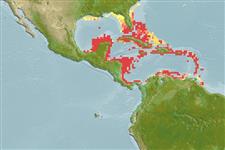Environment: milieu / climate zone / depth range / distribution range
Ecologia
marinhas associadas(os) a recifes; intervalo de profundidade 0 - 40 m (Ref. 9710). Tropical; 33°N - 7°N, 96°W - 58°W
Western Atlantic: Bermuda and southern Florida, USA to northern South America; throughout the Caribbean (Ref. 13442). Including Antilles (Ref. 26938).
Tamanho / Peso / Idade
Maturity: Lm ? range ? - ? cm
Max length : 29.0 cm FL macho/indeterminado; (Ref. 6937)
Espinhos dorsais (total) : 10; Raios dorsais moles (total) : 12. Snout long and pointed. Black stripes and bars forming irregular rectangles on body. Has unique pointed snout and distinct color pattern make it easy to identify (Ref. 26938).
Most common in areas with rock or scattered coral. Solitary or in pairs. Feeds mainly upon crustaceans (Ref. 5521). Synchronously hermaphroditic. The most common member of the genus (Ref. 9710).
Life cycle and mating behavior
Maturidade | Reprodução | Desova | Ovos | Fecundidade | Larvas
Displays facultative monogamy where males are constrained to mate with a single female due to resource limitation (Ref. 52884). Pelagic spawner (Ref. 32216).
Robins, C.R. and G.C. Ray, 1986. A field guide to Atlantic coast fishes of North America. Houghton Mifflin Company, Boston, U.S.A. 354 p. (Ref. 7251)
Categoria na Lista Vermelha da IUCN (Ref. 130435: Version 2024-1)
Can't connect to MySQL database (fbapp). Errorcode: Too many connections
